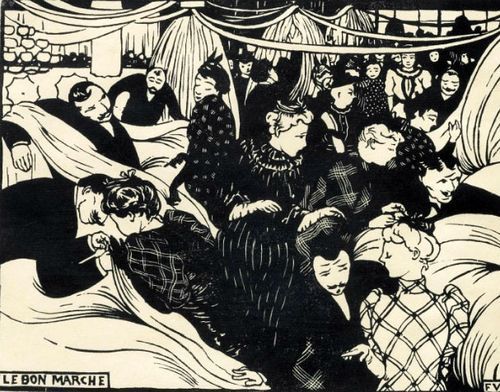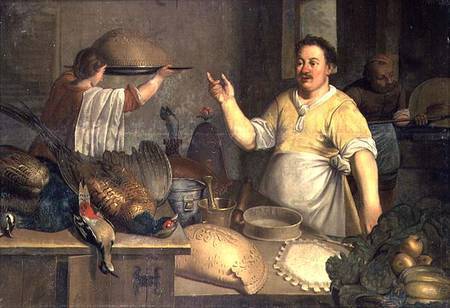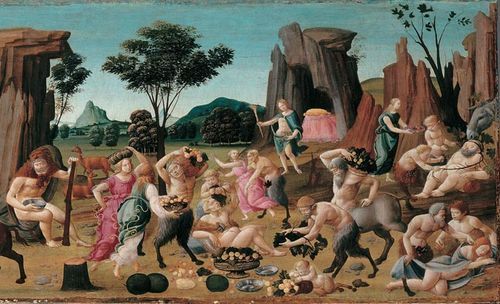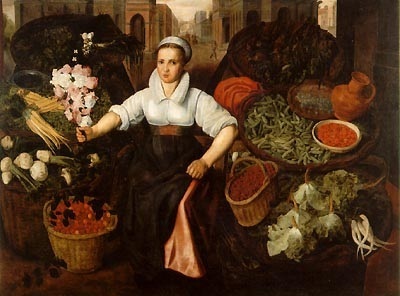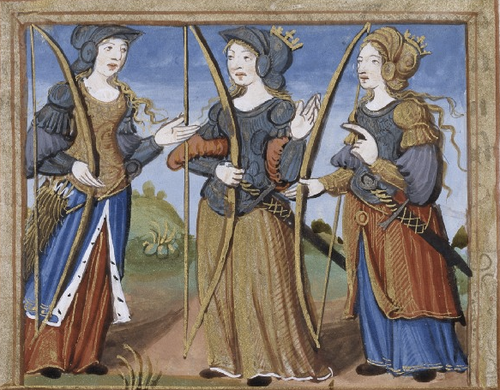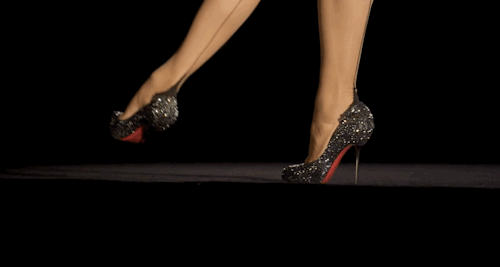Midori Snyder's Blog, page 41
March 25, 2015
Fiction and Family Meet At the Bon Marche
Quite a while ago I wrote about attending a conference in which one of the novels we were discussing was Emil Zola's terrific novel, Au Bonheur Des Dames (The Ladies Delight.) The novel, set in the late 1860's, centers on the invention of the department store (based on the historical store Bon Marché in Paris). The owner Mouret -- a scoundrel and womanizer -- is also a creative genius, gathering together all the different trades under one roof, creating "departments" and then using price incentives, advertising, and spectacular displays (worthy of Alexander McQueen) to draw women from all the classes ("democratizing luxury") into the store to shop in a sensual frenzy. The novel lingers on some of the most sensual and textural imagery -- with sumptuous passages -- which can be read here in my previous post.
I love the novel -- and so you can imagine my utter astonishment when I discovered this bit of family connection to Bon Marché -- which could have easily, easily been one of the narrative threads of Zola's novel! This was written in a memoir by my great-great uncle, the Rev. Francois Marie Menager, S. J. in the summer of 1964 about his grandfather Alcindor Parfait Le Provost, the father of his mother Henriette Provost.
"Grandpere Provost came from a wealthy family of Normandy. Most of his male relative were lawyers or teachers. His parents had eleven children and Mme Le Provost was provided for as his father was a successful lawyer and notary. His father was very generous to his friends and always ready to help them. He lent them quite a deal of money without being too careful about promissory notes. When he was about 50, he died suddenly. His widow and children found themselves practically ruined. All the debts were paid by the valiant widow, but the little money that was left was hardly enough to support the family. Then, the oldest of the children, my grandfather (Alcindor) Le Provost who was then about twenty years old, decided to go to Paris to make his fortune. He was bent on pulling his mother, brothers, and sisters out of their misery.
"When he got to Paris, he took a humble job as a clerk at the famous and original Bon Marché, a very successful store of general merchandise and of clothing. Grandpere Le Provost got interested in different sorts of cloth fabric. He studied and experimented a great deal for two to three years until one day he brought out a special cloth of his own invention calling it "English Broad Cloth." I believe that through the help of some of the kind officials of the Bon Marche, his cloth was brought to the attention of the public and it became a great success. Within a few years, he became a millionaire. He generously provided for his mother and his brothers and sisters. Through clever speculation he managed not only to keep his money but also increased his fortune substantially. He was a keen business man, making excellent deals and became one of the most successful Capitalists in Paris. When about 27 years of age, he married Mlle Menard -- one of the loveliest women in Paris. Their marriage was blessed with four children: two boys, Edouard and Ernest and two girls, Marie and Henriette."
How perfectly wonderful, and what serendipity it is to learn, that after spending three days steeped in discussing Zola's novel -- everything from the style of writing, to its ideas on commerce, money, business, luxury, the cloth industry, the rise and fall of fortunes, speculation, and the opportunity in a world that had not previously seen such -- to acquire wealth through hard work and entrepreneurial verve. Cool.
Happy Birthday Flannery O'Connor
A wonderful way to celebrate Flannery O'Connor's birth and death, is to listen to this very rare and wonderful recording of her reading "A Good Man Is Hard To Find" -- one of her best short stories. It is so different from reading this story to yourself, hearing instead her wry, deep Georgia drawl reading her work, and the audience laughing at the funny parts. And with Flannery, it is important to remember that even in the darkest parts of her stories, there is humor as well as violence. It really does change the way one perceives the story.

Sound Cloud Recording of "A Good Man Is Hard To Find."
March 21, 2015
The Cook and The Artist: Feeding Each Other
I have been doing research on food lately for the two novels set in the mid-16th century, partially to make sure that I won't make any grievous errors putting in a dish that wasn't around until a century later -- or and even more important -- miss the chance to put in a dish that by its very design and substance is more fantastic and magical than anything I could have dreamed up! Maybe that is part of the allure of research -- discovering that the facts are so much more satisfying to write about than the imagined ones.
 So to this lovely little book: Tastes and Temptations, Food and Art in Renaissance Italy by John Varriano -- an excellent examination of the relationship between the artists of the Renaissance and the great chefs of the same period. Varriano demonstrates the ways in which cooks and artists relied more on imagination in the production of their work (and often drawing inspiration from each other), and shared an affinity for ritual and the symbolic value of forms to represent the sacred, nature, and the senses. They were exercises in artifice to make aesthetic statements -- a salmon mousse molded to resemble a goat (so as to confuse and heighten the experience of eating one thing while imagining another) or an exquisite Ovidian scene of diners painted at the bottom of one's soup bowl. And in other ways, the relationship was organically close -- the artists creating still lifes using paints whose binding agents were mainly egg and lard.
So to this lovely little book: Tastes and Temptations, Food and Art in Renaissance Italy by John Varriano -- an excellent examination of the relationship between the artists of the Renaissance and the great chefs of the same period. Varriano demonstrates the ways in which cooks and artists relied more on imagination in the production of their work (and often drawing inspiration from each other), and shared an affinity for ritual and the symbolic value of forms to represent the sacred, nature, and the senses. They were exercises in artifice to make aesthetic statements -- a salmon mousse molded to resemble a goat (so as to confuse and heighten the experience of eating one thing while imagining another) or an exquisite Ovidian scene of diners painted at the bottom of one's soup bowl. And in other ways, the relationship was organically close -- the artists creating still lifes using paints whose binding agents were mainly egg and lard.
I started reading this study in part because I needed to know if the roasted peacock I placed in a scene was acceptable -- and then discovered after reading that I had in fact grossly under sold it in the scene. One of the great chefs of the mid 1500s, Bartolomeo Scappi, known for dramatic and delectable skill (a kind of culinary sprezzetura -- a word that needs a post of its own to explain) enjoyed cooking that "vainglorious creature," using an extravagant assortment of spices and a method of preparation that reassembled the bird with metal rods and reattached its feathers in order to serve it up come se fosse vivo-- "as if it were still alive." So yes -- my peacock is in. With bells and feathers and beak.
But this would have been one of many, many dishes. Consider this "simple meal" prepared by Scappi and his army of cooks -- a modest three course feast on a day of abstinence (meatless Friday) with forty guests, and "the first two courses consisted of fifty dishes served on four hundred pieces of gold, silver, and maiolica tableware," which were then followed by twenty-seven desserts served in two hundred and sixteen bowls and dishes. And..there were "six edible statues" of nymphs, exotic creatures and mythological inventions, "the first made of sugar; the second of butter; and the third, pasta." The meal then ended with scented toothpicks and posies of silk flowers with gold stems for each guest.
The hardest part now of writing that scene is going to be to reign in the desire to over indulge -- as artists and cooks are able to do -- so the reader won't somewhere midway through the scene, throw the book down and go in search of something good to eat. Like a pan of brownies or an entire brie with slices of pear, or a half a pound of prosciutto and green olives. Sigh...now I am hungry.
Art: Paolo Veronese, Wedding at Cana; Bartolomeo Passarotti, The Baker Prearing Pies; Bartolomea di Giovanni, The Wedding of Thetis and Peleus; Vincenzo Campi, Market Day.
March 20, 2015
Bordertown Again: Skateboarding and Writing
And here I am again, reminded of Bordertown -- first wrecks in the forest and now skateboarding -- which occupied a significant part of Alison Gross, a novella I wrote for Life on the Border (1991) and for which my research involved devouring skate magazines, gawking at cool stuff in skate shops, and watching endless videos posted by skaters in crumbling, fuzzy videos of spectacular flights and just as spectacular falls. It was so much fun back then to write the story and even more fun to watch the skaters. So, I was delighted at suddenly discovering an article by Claire Cameron about Michael Christie, a professional skateboarder now turned author. He explains in the article about the five ways skateboarding and writing are the same. And it is wonderful set of observations.
When comparing the physical pain to sitting all day (oh my aching back) and the constant injuries that come with skateboarding he argues that despite the pain, "...there is great pleasure in the physicality, too. When I’m on a roll, it feels like my body is possessed by some benevolent guiding force and hours zoom by, pain-free. I remember similar days on my skateboard when it felt like I could land just about anything I attempted. My legs were lighter, more springy. My balance was consistently zeroed in and my board seemed telekinetically bound to my will. What greater joy is there?"
And in another section he argues that both require there to be "blood on the ground," because in "both skateboarding and literature, there is that sublime moment when someone pulls something off that is clearly at the very outer limits of their ability, that is even perhaps beyond their ability, but yet it somehow worked out anyway — and this is where the true magic happens. Art is risk. That’s why it captivates us. And if a writer taking this risk has left a little (metaphorical!) blood on the ground, then all the better for those watching. The spatter is how we know they meant it.”
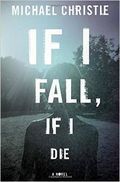 I have ordered Michael Christie's novel, If Fall, If I Die, (already garnering excellent reviews) because it sounds fascinating and because there is a journey to an unknown "Outside" and the conveyance is a skateboard. And probably because I have already had a glimpse from the article about the beautiful way Michael Christie writes about skateboarding, describing a boy doing an ollie , as “frozen like a cat stalking a robin, before cracking the rear of the board down, rocketing himself upward with the apparatus clinging impossibly to his feet like a burr.” Yeah...I'm hooked.
I have ordered Michael Christie's novel, If Fall, If I Die, (already garnering excellent reviews) because it sounds fascinating and because there is a journey to an unknown "Outside" and the conveyance is a skateboard. And probably because I have already had a glimpse from the article about the beautiful way Michael Christie writes about skateboarding, describing a boy doing an ollie , as “frozen like a cat stalking a robin, before cracking the rear of the board down, rocketing himself upward with the apparatus clinging impossibly to his feet like a burr.” Yeah...I'm hooked.
March 16, 2015
Bordertown Moments: Abandoned Wreck in the Forests of the Neverever.
It always amazes me when I run into an image or an article that feels so much at home at Bordertown (the series of young adult novels edited by Terri Windling, and more recently by Holly Black and Ellen Kushner). I wrote three Bordertown stories and loved the experience of working in a shared world anthology -- where a group of writers get together and create city, characters, shared events, and bring a place to life. Bordertown continues to excite younger generations, despite it being now almost thirty years old.
And still I feel a pull back to the world of Bordertown, back to the unpredictable city hovering over the border between the World and Elfland. It hasn't lost its punk feel -- its effort to re-imagine rites of passage as ambiguous movements through city streets, wildspace, art, and grunge, human and fantastic.
So I loved this as soon as I saw it, the Whistler Train Wreck, derailed in 1956 in British Columbia, crashing through the forest. It was deemed too impossible to remove, and so it has been left there. Over time it has become a spot for graffiti artists to practice their skills, and it has been slowly decaying into the surrounding soil. And it struck me, how interesting this train would be if it were lost in the Neverever Forests that surround Bordertown -- a no man's land really, where danger, and things not quite willing to civilize in one world or the other inhabit. A train wreck with its rust and iron would be as dangerous to the fey as the various monsters -- human and fantastic -- reputed to habit the forest.
And all of that to say -- I feel like I need to go back to Bordertown. There's a story in this.
March 10, 2015
Clive Hicks Jenkins and his Evocative Book Illustrations for Youmans' Maze of Blood
There is something fabulous (and enviable for this writer) at the fertile co-creative spirit between an author and a book illustrator. Over the years, author Marly Youmans has worked with artist Clive Hicks Jenkins to create stunning books -- old school style with beautiful original color artwork for the covers, and lovely black and white smaller pieces for the interior. It is such a pleasure to hold those books and read them for Marly's wonderful prose and story telling, and to linger over Clive's remarkable art -- not so much straight illustrations of the narrative, but highly evocative images that add a whole other layer to understanding the internal emotions of the tale.
Most recently, I reviewed Marly's lastest novel Maze of Blood (forthcoming from Mercer University Press this fall). It's a haunted story of its own -- a man who lives almost entirely in the interior world of his imagination while inhabiting a less than receptive world in a backwater Texas town. But I want to celebrate Clive Hicks Jenkins' part in creating gorgeous and powerful art to illsutrate the book.
Clive chose to focus his work on multiple portraits of the protagonist Conall in various moments throughout the narrative, each portrait visually conveying Conall's state of mind. He is still working on the final interior pieces, which unlike the brilliant colors of the book's cover jacket, these drawings are rendered in soft grays and velvet textures. I strongly recommend stopping by his art blog and enjoying watching him work -- as he posts more photos of the art in process, and as he develops his ideas from sketch to finished piece. How lucky we are to be able to observe that journey.
“In the end, he thought, a neat labyrinth or an untidy maze was a place that was simple. You reached its heart and were devoured by the beast, or you reached its heart and the spot was absolutely bare and pulseless. Maybe the beast and the blankness were the same. Maybe it was the emptiness that had teeth and hollowed you out.” from Marly Youmans Maze of Blood.
March 6, 2015
Suffering the Scourge of Tax Time
I should be better come Monday -- when the horror of tiny chits of paper filled with dollar amounts, donations, deductions, reductions, abductions, and all the other nonsense afforded to tax-time calculations is finito. (Except for the furious weeping and writing of checks.)
March 5, 2015
Banished Brides and Longbows
I found this lovely image --most likely of the great warrior Queen, Matilda of Tuscany and thought how familiar she looks, banded together with her sisters-in-arms, swords and longbows, arrows and beautiful dresses. Though Matilda was certainly far more powerful and effective as a warrior queen, this image seemed like a perfect illustration for a band of querulous brides that appear in Zizola's novel.
More than awhile ago, I wrote about the peculiar figure of the "banished bride" in folktales and ballads --- the bride who unwittingly stands in for the heroine until she can extricate herself from whatever impediment has kept her temporarily from her intended groom. The poor dear is then banished at the altar -- sent home, and even though financially compensated, her honor and reputation dimmed. Here's what I wrote in that post:
"So what happens to those banished brides -- not the deceitful and disguised brides, they always meet with bad ends -- but those brides like poor Anne of Cleves determined too ugly (and "too swarthy") by Henry the Eighth and sent home as unsuitable. Since we never get their side of the story, or the what-ever-happened-to-that-young-woman?, the writer in me couldn't resist wondering what those women might do to reclaim themselves if given a chance in a novel. A young writer I know suggested they went home with a huge sigh of relief -- imagining that such weddings to total strangers would have been scary enough to contemplate.
But from a narrative point of view, that's no fun -- especially after reading the Lost Sicilian Folk and Fairy Tales of Laura Gonzenbach, I know that the Italians -- or at least the Sicilians-- are firm believers in spectacular revenge. So I couldn't help but think of a sisterhood of Banished Brides coming together and taking their fury on the road to extract some form of punishing compensation. A band of marauding almost-brides offering to my young heroine roadside companionship and rancorous cautionary tales about men in general. (Although I suspect the trickster traveling with her would not be able to resist the temptation of meddling with those dangerous women.) Well...there's a few chapters to meditate on and then to write."
Queen Matilda was certainly no banished bride -- though she did have an awful marriage to a stepbrother -- but she seems to have compensated for all the short comings of an unhappy marriage by becoming a highly effective military commander and fighter. All in the 12th century, which is pretty remarkable.
March 2, 2015
What Every Woman Needs -- Firebird and Ashes Shoes
After a week of grubby traveling through cold unforgiving weather, who would not want to come home to a spectacular and fantastical pair of Firebird and Ashes shoes?? Here is a brief description of these fiery beauties:
"These pumps, crafted by Mexican designer Lucita Abarca, caused quite a stir at a recent Sixth Borough fashion show. These crystalline high-heels were grown by Wyrm’s Pass artisans, deep below the Rocky Mountains, using a mixture of firebird ash, waters from the springs at Paradiso, and a variety of secret ingredients, rumored to include Australian fire opals and powdered moonstone. The result of using the firebird ash become immediately recognizable when the heel of the shoe is dragged backward across any dry surface, as it creates an impressive streak of magical fire which can be accurately aimed with a little effort. Ms. Abarca said she wanted a shoe that made a statement, and that statement was “Any bastardo brujo catcalling me on La Plaza de Sangre better be ready to dose his huevos, you know?"
Ok -- this is a fun bit of fantasy, though when I first read it at Once Upon a Blog, I was thrilled and ready to reach for a credit card. Still -- just coming up with the idea is pretty terrific! I wonder how many fiery shoes we will be seeing in new urban fantasy novels? Stop by Once Upon a Blog, and enjoy the rest of Gypsy Thornton's post on variants and productions of the Firebird tale. It'll warm you up in a hurry.
What Every Woman Need -- Firebird and Ashes Shoes
After a week of grubby traveling through cold unforgiving weather, who would not want to come home to a spectacular and fantastical pair of Firebird and Ashes shoes?? Here is a brief description of these fiery beauties:
"These pumps, crafted by Mexican designer Lucita Abarca, caused quite a stir at a recent Sixth Borough fashion show. These crystalline high-heels were grown by Wyrm’s Pass artisans, deep below the Rocky Mountains, using a mixture of firebird ash, waters from the springs at Paradiso, and a variety of secret ingredients, rumored to include Australian fire opals and powdered moonstone. The result of using the firebird ash become immediately recognizable when the heel of the shoe is dragged backward across any dry surface, as it creates an impressive streak of magical fire which can be accurately aimed with a little effort. Ms. Abarca said she wanted a shoe that made a statement, and that statement was “Any bastardo brujo catcalling me on La Plaza de Sangre better be ready to dose his huevos, you know?"
Ok -- this is a fun bit of fantasy, though when I first read it at Once Upon a Blog, I was thrilled and ready to reach for a credit card. Still -- just coming up with the idea is pretty terrific! I wonder how many fiery shoes we will be seeing in new urban fantasy novels? Stop by Once Upon a Blog, and enjoy the rest of Gypsy Thornton's post on variants and productions of the Firebird tale. It'll warm you up in a hurry.
Midori Snyder's Blog
- Midori Snyder's profile
- 87 followers


